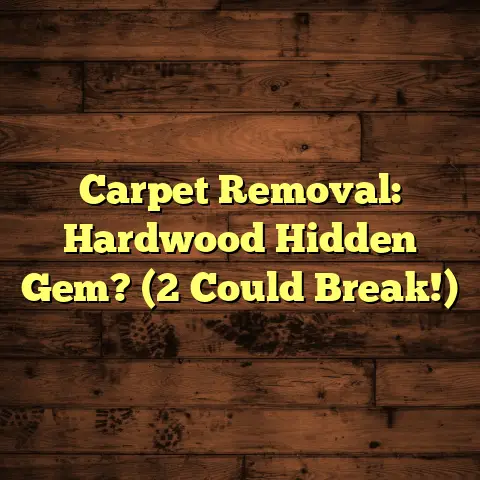Does Ash Make Good Hardwood Flooring?
It’s incredible how far flooring has come,
right?
From simple planks to engineered masterpieces,
we’ve seen it all.
One wood that’s been gaining traction is ash.
But does ash really make good hardwood flooring?
That’s the million-dollar question, isn’t it?
We’ll explore its durability, looks, cost,
and even its sustainability.
Choosing the right wood is crucial.
It’s not just about looks; it’s about
your lifestyle and budget too.
So, grab a coffee and let’s get started!
Section 1: Understanding Ash Wood
1.1 Overview of Ash Species
Ash wood comes in different flavors, my friend!
You’ve got your Northern Red Ash (also known as White Ash) and your Black Ash, among others.
Northern Red Ash is the star of the show for
flooring.
It’s got a creamy white to light
brown color, with a grain that’s generally
straight and consistent.
Black Ash tends to be a bit softer and more flexible, making it better suited for things like basket weaving.
Visually, ash has this beautiful, open-pore grain
that can really add character to a room.
It’s like nature’s own fingerprint on your floor!
The color variations are subtle but noticeable, giving you options for different aesthetics.
1.2 Geographic Distribution
Where does all this ash come from? Well, primarily North America.
You’ll find ash trees thriving in the eastern United States and Canada.
The availability of ash is something we need to consider, especially with the Emerald Ash Borer (more on that later!).
Sourcing locally, when possible, is always a good move for sustainability.
1.3 Physical Properties
Let’s talk numbers! Hardness is a big deal when it comes to flooring.
Ash clocks in at around 1320 on the Janka hardness
scale.
What does that mean?
Well, oak, a super popular choice, is around 1290. Maple is tougher, around 1450.
So, ash is pretty darn durable!
It can handle everyday wear and tear, but it’s
not indestructible.
Density-wise, ash is moderately dense, which contributes to its strength and resilience.
Compared to softer woods like pine, ash is a
clear winner.
It’s got the muscle to withstand
foot traffic and furniture.
Section 2: The Benefits of Ash as
Hardwood Flooring
2.1 Aesthetic Appeal
Okay, let’s be honest: looks matter!
Ash has a naturally light color that makes it a fantastic canvas for stains.
Want a modern, minimalist vibe? Go for a light, natural finish.
Craving something warmer and richer? A darker stain will bring out the grain beautifully.
I’ve seen ash floors used in everything from Scandinavian-inspired interiors to rustic farmhouses.
Its versatility is a huge selling point.
The straight grain pattern is also a plus.
It creates a clean, uniform look that can make
a room feel more spacious.
2.2 Durability and Performance
How tough is ash, really?
As I mentioned before, its Janka hardness score is
respectable.
It can handle kids, pets, and the
occasional dropped mug.
But here’s the thing: all wood dents eventually. Ash is no exception.
However, its density helps it resist dents and scratches better than softer woods.
I’ve seen ash floors hold up well in high-traffic areas, especially when properly maintained.
Think hallways, living rooms, and even kitchens.
(Just be mindful of spills in the kitchen!)
2.3 Sustainability
Now, let’s get to the elephant in the room: the Emerald Ash Borer.
This invasive insect has devastated ash populations across North America.
It’s a serious problem, and it impacts the sustainability of ash as a flooring material.
However, there are efforts to combat the borer and promote responsible harvesting practices.
Look for ash flooring that’s certified by the Forest Stewardship Council (FSC).
This ensures that the wood comes from sustainably managed forests.
The good news is that ash trees grow relatively quickly, which makes them a renewable resource when managed properly.
2.4 Cost-Effectiveness
What’s the damage to your wallet?
Ash flooring typically falls in the mid-range price category compared to other hardwoods.
It’s generally more affordable than exotic woods like Brazilian cherry, but it might be slightly more expensive than some types of oak.
Installation costs are similar to other hardwood
floors.
You’ll need to factor in the cost of
underlayment, adhesives, and labor.
In the long run, ash flooring can be a cost-effective choice.
Its durability means you won’t have to replace it as often as you would with a cheaper, less durable option.
Section 3: Challenges and Limitations of
Ash Flooring
3.1 Susceptibility to Damage
Okay, it’s not all sunshine and roses.
Ash, like any wood, is susceptible to moisture.
Excessive humidity can cause it to expand, and dryness can cause it to contract.
This can lead to warping, cupping, and cracking. Yikes!
That’s why it’s crucial to maintain a consistent humidity level in your home.
A dehumidifier in the summer and a humidifier in the winter can make a big difference.
Spills should be cleaned up immediately to prevent water damage.
And avoid using harsh chemicals when cleaning your ash floors.
3.2 Availability and Supply Issues
The Emerald Ash Borer has definitely impacted the availability of ash wood.
In some areas, it can be harder to find than it used to be.
This can drive up the price and potentially lead to longer lead times.
It’s important to work with a reputable flooring supplier who can source ash from sustainable sources.
Ask about the origin of the wood and whether it’s been treated to resist insect damage.
3.3 Consumer Perception
Let’s face it: oak and maple are the rock stars of the hardwood flooring world.
Ash is still a bit of an underdog.
Some consumers might not be as familiar with it,
which can lead to hesitation.
However, ash is gaining popularity as more people discover its beauty and durability.
It’s a great alternative to more common hardwoods, and it can add a unique touch to your home.
Don’t be afraid to be a trendsetter!
Section 4: Installation and Maintenance of
Ash Flooring
4.1 Installation Process
Alright, let’s get down to the nitty-gritty of installation.
Whether you’re going with solid or engineered ash flooring, the process is pretty similar to other hardwoods.
First, you’ll need to prep the subfloor. It should be clean, level, and dry.
An underlayment is essential.
It provides a moisture barrier, reduces noise, and
adds a bit of cushioning.
For solid hardwood, you’ll typically nail or staple the planks to the subfloor.
Engineered hardwood can often be floated, glued, or nailed, depending on the manufacturer’s recommendations.
Leave expansion gaps around the perimeter of the room to allow for natural movement.
And always follow the manufacturer’s instructions!
Trust me, it’ll save you headaches down the road.
4.2 Maintenance Tips
Okay, you’ve got your beautiful ash floors installed.
Now, how do you keep them looking their best?
Regular sweeping or vacuuming is key to remove dirt and debris.
Use a microfiber mop and a pH-neutral wood floor cleaner.
Avoid using excessive water, as it can damage the wood.
Place mats at entrances to trap dirt and moisture.
And use felt pads under furniture legs to prevent
scratches.
Every few years, you might want to consider screen-and-recoat to refresh the finish.
This will protect the wood and keep it looking shiny and new.
Section 5: Comparing Ash with Other
Hardwood Options
5.1 Comparative Analysis
Let’s put ash head-to-head with some other popular hardwood choices.
As you can see, ash holds its own in terms of hardness and cost.
Oak is a classic choice, but ash offers a slightly different aesthetic.
Maple is tougher, but it can be more expensive.
Hickory is the most durable, but it also comes with
a higher price tag.
5.2 Consumer Preferences
Why might someone choose ash over oak or maple?
Well, its light color and straight grain can create a bright, airy feel in a room.
It’s also a great choice for those who want a versatile floor that can be stained to match any decor.
Some homeowners are drawn to its unique character and the fact that it’s not as common as other hardwoods.
Ultimately, the best choice depends on your personal preferences, budget, and lifestyle.
Conclusion
So, does ash make good hardwood flooring?
The answer is a resounding “it depends!”
Ash has a lot going for it: beauty, durability, and versatility.
But it also has some challenges, like susceptibility to moisture and potential supply issues.
If you’re looking for a unique and stylish hardwood floor, ash is definitely worth considering.
Just be sure to do your research, choose a reputable supplier, and maintain it properly.
Thanks for joining me on this deep dive into the world of ash flooring!
I hope this article has been helpful in your flooring journey. Happy remodeling!





